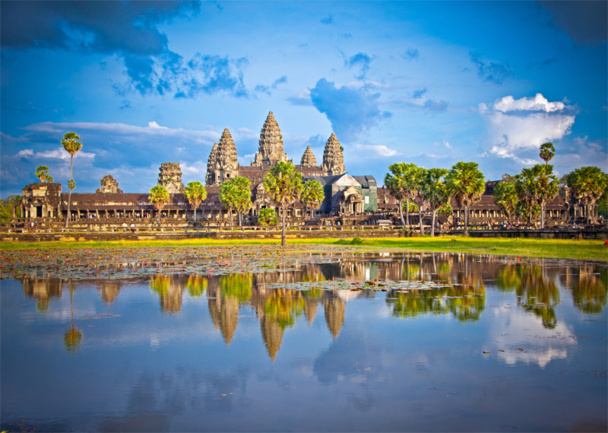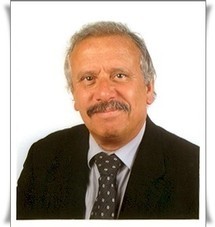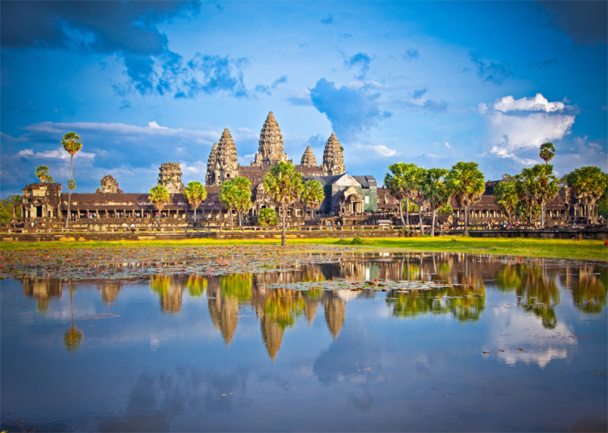
The Angkor temple in Cambodia was absolutely not visited until the 80s, and after its ranking in 1992, it attracted 60,000 visitors in 1999, 250,000 in 2001 and 3 million visitors in 2011 © Aleksandar Todorovic - Fotolia . com
The French channel, Canal Plus, has released a “special investigation" show on the sidelines of the UNESCO and its committee in charge of awarding the label "Heritage of Humanity" to sites that meet certain criteria.
Beyond its deliberately provocative aspect, the issue the show raised was the pressures exerted by states seeking recognition of the heritage even though they do not meet the necessary qualifications for the label.
Lobbying and secret negotiations are certainly of the same nature as those prevailing at the Olympic committees for the appointment of the host cities of the Olympic Games or to designate the organizing country for the World Cup.
Often, the selections are surprising and follow unexpected logic.
In most cases, money, favor returns, rewards are more convincing arguments than the intrinsic quality of a historic site or sports facilities.
Beyond its deliberately provocative aspect, the issue the show raised was the pressures exerted by states seeking recognition of the heritage even though they do not meet the necessary qualifications for the label.
Lobbying and secret negotiations are certainly of the same nature as those prevailing at the Olympic committees for the appointment of the host cities of the Olympic Games or to designate the organizing country for the World Cup.
Often, the selections are surprising and follow unexpected logic.
In most cases, money, favor returns, rewards are more convincing arguments than the intrinsic quality of a historic site or sports facilities.
981 sites listed in the Unesco
Currently 981 sites are classified as "Humanity Heritage" or "World Heritage".
These 981 sites are spread over 169 states, 759 are classified as cultural, 193 are classified as "natural" and 29 are mixed.
Each year UNESCO awards the label to 30 new sites.
The label "Heritage of Humanity" is an engine of economic development for the state or the beneficiary regions because these ecological or historical sites are then the center of tourism projects and become the alibi for businesses that have nothing to do with the original cultural purpose of the site.
It is for this reason that the 21 ambassadors of the Selection Committee’s member countries are subject to diplomatic backstage maneuvers and pressures from emerging powers that have the means to influence decisions, as they are thirsty for cultural recognition, a luxury that had so far been reserved to the Old Continent’s nations.
These 981 sites are spread over 169 states, 759 are classified as cultural, 193 are classified as "natural" and 29 are mixed.
Each year UNESCO awards the label to 30 new sites.
The label "Heritage of Humanity" is an engine of economic development for the state or the beneficiary regions because these ecological or historical sites are then the center of tourism projects and become the alibi for businesses that have nothing to do with the original cultural purpose of the site.
It is for this reason that the 21 ambassadors of the Selection Committee’s member countries are subject to diplomatic backstage maneuvers and pressures from emerging powers that have the means to influence decisions, as they are thirsty for cultural recognition, a luxury that had so far been reserved to the Old Continent’s nations.
The economic stakes extend far beyond the original purpose
The small arrangements between states are not up to the tasks of the organization.
The economic stakes extend far beyond the original purpose of the label that primarily calls for the preservation of a World Heritage .
What is above all surprising for an organization like UNESCO: the United Nations Organization for Education, Science and Culture, is the total lack of evaluation of the social and ecological impact such a label has on the human and ecological environment.
Indeed, the ranking of these sites allows an extra attractiveness that is tenfold by the international media coverage of the "Heritage of Humanity" label.
Some places have exploding attendance rates that far exceed capacity, leading to an impossibility of absorbing this overcrowding without damages.
Some regions have shifted from complete anonymity to international fame with the UNESCO label.
This is the case of the Angkor temple in Cambodia that in the 80s was not visited, and after its ranking in 1992, attracted 60,000 visitors in 1999, 250,000 in 2001 and 3 million visitors in 2011.
This explosion led to a series of damages due to uncontrolled flow of tourists, such as graffiti, massive trampling that weakens the site, road traffic leading to gas emissions that cause stone erosion.
Not to mention the widespread corruption and social misery of the people, some of whom live on less than a dollar a day, despite the high revenues that the label generates.
The economic stakes extend far beyond the original purpose of the label that primarily calls for the preservation of a World Heritage .
What is above all surprising for an organization like UNESCO: the United Nations Organization for Education, Science and Culture, is the total lack of evaluation of the social and ecological impact such a label has on the human and ecological environment.
Indeed, the ranking of these sites allows an extra attractiveness that is tenfold by the international media coverage of the "Heritage of Humanity" label.
Some places have exploding attendance rates that far exceed capacity, leading to an impossibility of absorbing this overcrowding without damages.
Some regions have shifted from complete anonymity to international fame with the UNESCO label.
This is the case of the Angkor temple in Cambodia that in the 80s was not visited, and after its ranking in 1992, attracted 60,000 visitors in 1999, 250,000 in 2001 and 3 million visitors in 2011.
This explosion led to a series of damages due to uncontrolled flow of tourists, such as graffiti, massive trampling that weakens the site, road traffic leading to gas emissions that cause stone erosion.
Not to mention the widespread corruption and social misery of the people, some of whom live on less than a dollar a day, despite the high revenues that the label generates.
Another example is the rice terraces in YUANYANG
Another example: the landscape of rice terraces in YUANYANG, China that were awarded the “Heritage of Humanity” in 2013.
Besides the spectacular aesthetics of this natural geometric decor with its cold colors, this is primarily a true ancestral organization around water that allows the beauty of the rice fields and that maintains the food autonomy of the population.
Since the ranking of the site, many farmers have abandoned their crops to invest in minibuses or in the construction of hotels focusing on tourism development.
Thus, might this classification, that was originally intended to preserve a natural site, backlash against the UNESCO, because of a lack of structure, when all farmers have abandoned their fields and the fallow rice terraces lose their appearance or appeal?
Will it come to a point when we will see in the middle of roads and hotels only one or two artificially maintained rice terraces to show tourists a vestige of the past?
Besides the spectacular aesthetics of this natural geometric decor with its cold colors, this is primarily a true ancestral organization around water that allows the beauty of the rice fields and that maintains the food autonomy of the population.
Since the ranking of the site, many farmers have abandoned their crops to invest in minibuses or in the construction of hotels focusing on tourism development.
Thus, might this classification, that was originally intended to preserve a natural site, backlash against the UNESCO, because of a lack of structure, when all farmers have abandoned their fields and the fallow rice terraces lose their appearance or appeal?
Will it come to a point when we will see in the middle of roads and hotels only one or two artificially maintained rice terraces to show tourists a vestige of the past?
Places still off the UNESCO’s radar
As it happened to POMPEII, the sleeping city, the country has not fulfilled its maintenance mission and the flow of tourists has not been properly regulated.
In consequence, out of the 50 homes open to visitors a few years ago, there remains only 2 or 3 set as "display homes" and colossal work financed by the international community should be initiated to renovate the whole site.
The Taj Mahal in India, a place of delicate beauty, the carved mausoleum in white marble that stands out in the sky is also in danger. It is a 17th century emperor who built this monument out of love for his wife Mumtaz who died giving birth to their 14th child.
This lovesick emperor certainly had not imagined that this temple dedicated to intimacy would host more than 10,000 visitors per day who are "unleashed" without any regulation in the gardens and apartments like a mob in supermarkets during sales.
There are still magical place off the UNESCO radar such as Bagan in BURMA, where cohabit over 2,000 temples and pagodas in a perimeter of 50 km2.
Burma is opening to democracy, which is great, but let’s hope that this unique site will not be the target of more devastating tourism.
In consequence, out of the 50 homes open to visitors a few years ago, there remains only 2 or 3 set as "display homes" and colossal work financed by the international community should be initiated to renovate the whole site.
The Taj Mahal in India, a place of delicate beauty, the carved mausoleum in white marble that stands out in the sky is also in danger. It is a 17th century emperor who built this monument out of love for his wife Mumtaz who died giving birth to their 14th child.
This lovesick emperor certainly had not imagined that this temple dedicated to intimacy would host more than 10,000 visitors per day who are "unleashed" without any regulation in the gardens and apartments like a mob in supermarkets during sales.
There are still magical place off the UNESCO radar such as Bagan in BURMA, where cohabit over 2,000 temples and pagodas in a perimeter of 50 km2.
Burma is opening to democracy, which is great, but let’s hope that this unique site will not be the target of more devastating tourism.
UNESCO should involve tourism professionals
The label assigned by UNESCO should allow humanity to reconstruct its history in regions where the builders of temples, by faith or love, have advanced civilization in the way of progress. Such unregulated tourism risks of eliminating the witnesses to these civilizations.
UNESCO should associate tourism professionals from the generating countries and the countries where these landmarks of human history stand.
Together we must find commercially acceptable terms to supervise the visits of the world’s cultural and natural heritages.
Without this cooperation, the loose and unsupervised UNESCO label is the same as discovering a new pharmaceutical drug that is left to unrestricted sale without a doctor interfering to issue a prescription.
We, travel agencies and tour operators, must be the "processors" of these assets.
We can vouch for the preservation of the sites by raising awareness with our customers but also by recognizing the respect of the people and environments that are an integral part of this preservation.
UNESCO needs to complete its process by not only enriching our tourism production through the revelation of new heritages but also by imposing operating conditions of these sites, and this where the expertise of tourism professional comes in.
UNESCO should associate tourism professionals from the generating countries and the countries where these landmarks of human history stand.
Together we must find commercially acceptable terms to supervise the visits of the world’s cultural and natural heritages.
Without this cooperation, the loose and unsupervised UNESCO label is the same as discovering a new pharmaceutical drug that is left to unrestricted sale without a doctor interfering to issue a prescription.
We, travel agencies and tour operators, must be the "processors" of these assets.
We can vouch for the preservation of the sites by raising awareness with our customers but also by recognizing the respect of the people and environments that are an integral part of this preservation.
UNESCO needs to complete its process by not only enriching our tourism production through the revelation of new heritages but also by imposing operating conditions of these sites, and this where the expertise of tourism professional comes in.

Christian OROFINO
President of TOURCONSEIL
Co-President of the OBGET
Former CEO and CEO of VISIT TO FRANCE
Chairman of the Responsible Tourism Committee, SNAV
Co-President of Policy and Environmental Geo Tourism Observatory (OBGET)
OBGET Facebook page
President of TOURCONSEIL
Co-President of the OBGET
Former CEO and CEO of VISIT TO FRANCE
Chairman of the Responsible Tourism Committee, SNAV
Co-President of Policy and Environmental Geo Tourism Observatory (OBGET)
OBGET Facebook page



























![De l’auberge de jeunesse au Generator : toute une histoire [ABO] De l’auberge de jeunesse au Generator : toute une histoire [ABO]](https://www.tourmag.com/photo/art/large_16_9/93247694-65219608.jpg?v=1765984636)















